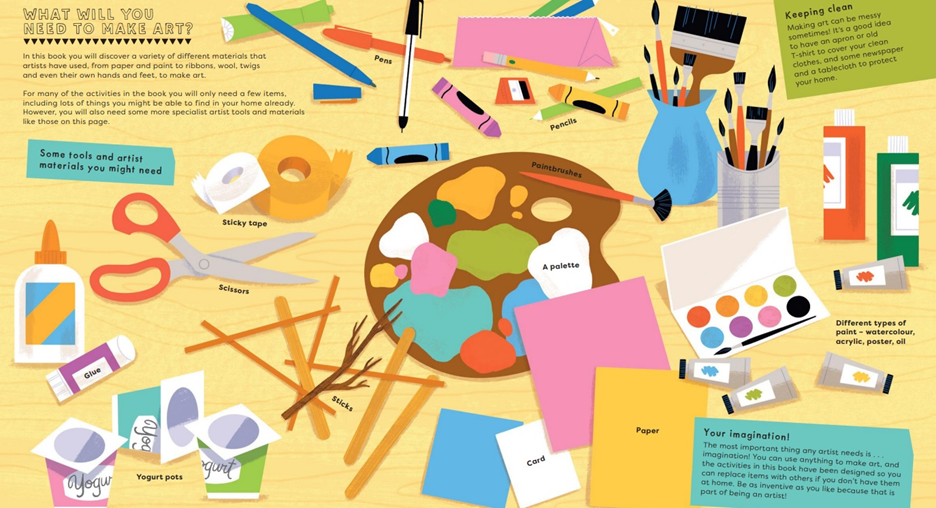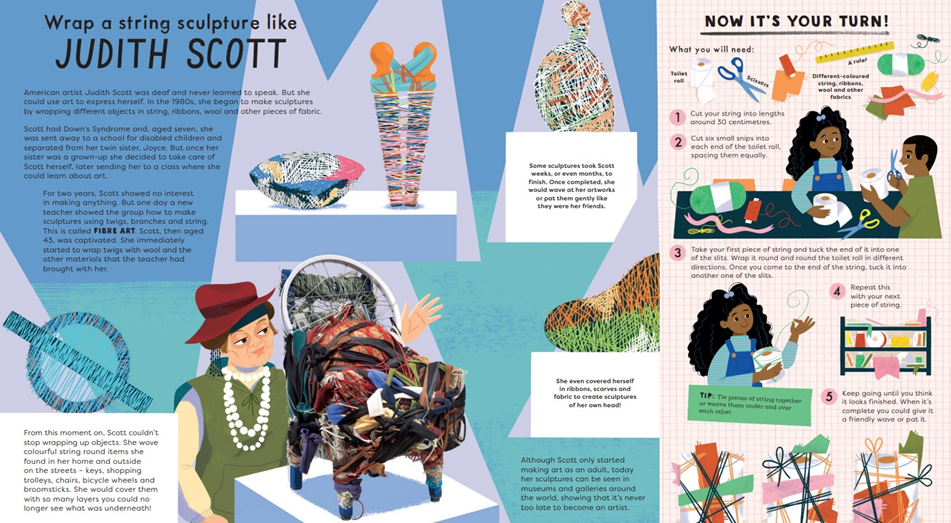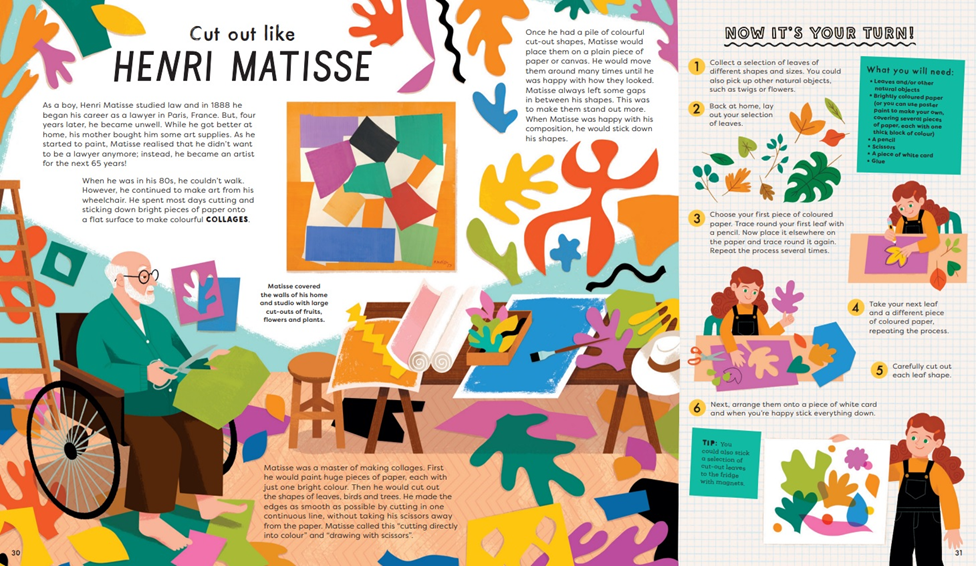Ruth Millington


About Author
Ruth Millington is a Birmingham-based art critic and writer whose has now written a book to inspire children as artists; This Book Will Make You an Artist. After studying art history at Oxford University, Ruth worked in galleries for five years. Today, she writes about art for national newspapers, and appears as an expert on radio and TV.
Interview
This Book Will Make You an Artist (Nosy Crow)
February 2024
Author Ruth Millington has brought her experience in the world of art to her first book for children, This Book Will Make You an Artist, illustrated by Ellen Surrey, aims to encourage children to create their own art, inspired by artists through history. A variety of techniques and approaches are explored through the book, and child-friendly ideas for activities offered.
We asked Ruth Millington to tell us more about her work in art, what inspired her to write This Book Will Make You an Artist, and how we can use her new book to help inspire the artist in children.
Review: "This is a perfect book to use with children to expand their knowledge of artists, artwork and to extend their creativity."
Read an extract from This Book Will Make You An Artist
Q&A with Ruth Millington
"By having fun with different materials, taking inspiration from art history, and with a little bit of practice,
I really do believe that anyone can be an artist."
1. Can you tell us a little about yourself and how you became an author?
For as long as I can remember, I've always loved writing stories. I can recall sitting in a caravan, aged about six, during one family holiday and dreaming up worlds on paper. Then, at secondary school, I had a fantastic art teacher who introduced me to painting, drawing and the great stories of art history. I was hooked! Combining both art and writing in a liberal arts degree at university led me to work in various museums and galleries, before I began to focus fully on writing about art - for newspapers, magazines and, now, books.
2. What was your aim with This Book Will Make you an Artist? Why did you want to make a book like this available to children?
We usually separate the history of art from practical art activities. But we shouldn't! From Picasso's Cubism we can understand how to portray objects from multiple perspectives, Barbara Hepworth shows us how to sculpt from nature, and Paul Signac helps us to understand colour theory.
I wrote this book, which includes step-by-step activities, as a means of inspiring children to experiment with new methods of making. By having fun with different materials, taking inspiration from art history, and with a little bit of practice, I really do believe that anyone can be an artist.

3. What kind of activities are included in This Book Will Make you an Artist and how is it organised?
The book features 25 diverse artists from around the world, and in chronological order, who each share a creative activity with readers. Following an interactive introduction, the book starts with prehistoric cave painters, before moving onto mosaic makers in Ancient Rome and the likes of Leonardo da Vinci, Artemisia Gentileschi and Moses Williams. Children are then introduced to great modern artists, and the book ends with a number of contemporary artists, including Bridget Riley.
I also wanted to ensure that the book included both 2D and 3D activities, so there's weaving, spray painting, hat making, sculpture and much more, with each artist representing a different style or technique.
4. Can you tell us about the artists you have chosen, and why those artists are included?
There were too many great artists to choose from. However, I was determined that the book would celebrate some well-known names alongside lesser-known figures from around the world and diverse cultures, from China to Mexico, and from the ancient world to today. Yes, there's Claude Monet and Pablo Picasso, whose names everyone will know. But, just as important to me was including Esther Malangu, Judith Scott and Moses Williams.
5. Can you describe a couple of the art activities you suggest in the book, and what kinds of resources children will need to make them?
One of my favourite activities from the book is 'Wrap a string sculpture like Judith Scott'. She was a deaf fibre artist who wrapped hundreds of objects in string and ribbons. I developed a range of art and craft activities that can be made using everyday, accessible materials, and this one only requires a toilet roll, string or threads, and a pair of scissors.
I don't want cost to be a barrier and art shouldn't have to require families or teachers to buy expensive materials. Other activities including 'Make an abstract mobile like Hilma Af Klint', for which children will need paper plates, or 'Carve a sculpture like Barbara Hepworth' which requires a small bar of soap!

6. Why do you feel it's important for children to have this kind of 'hands on' activity for different artists - not just learning about their work academically?
You can only really appreciate how great artworks are once you've had a go yourself. Last year, I took a print making course and wow, was it hard! I now have a newfound appreciation for printmakers, who combine colour and images in various layers, always thinking ahead about their compositions.
By making art, children learn to look more carefully - not only at what they are making, but at masterpieces, as well as the world around them. In this fast-paced and digital world, hands on activities also allow children space away from screens and time to slow down a little.
7. Have you tried out the activities with children? How do children respond?
When I was writing the book, I had a six-year old helper, Lola, who read through some of the artist's stories and gave me feedback - and she didn't hold back! The more fun facts, the better, she told me. It made me research in more detail the strange and surprising sides to artists' lives. Hokusai was a great Japanese printmaker, but he was also very messy. Rather than tidying up his studio, he would just move to another one!
Having previously worked in museum education, I also included some art activities which I had tried and tested with school groups in the past. The Matisse paper cut outs session was always a fun, colourful and popular one, so I knew that it had to make it into this book.

8. Do you think it will also be useful in classrooms? How can teachers use the book to help children develop as artists - and to cover any curriculum links?
I really hope that teachers will use this book in their classrooms! Each double page spread acts as a lesson plan, with an introduction to the artist first, followed by a hands-on activity, teaching children to use their imagination and express their ideas.
I developed themes that link well to the National Curriculum's Key Stages 1 and 2, with readers encouraged to develop a wide range of art and design techniques in using colour, pattern, texture, line, shape, form and space. Each of the 25 activities teaches a different style or technique, as well as period from art history.
9. Do you have any other suggestions for developing this more widely to encourage children's creativity?
Before or after working directly from the book, I would really recommend a trip to a museum or gallery where the class/children can see work by one or more of the artists hanging on the wall. For children and schools in the UK, Art UK is a wonderful resource as it lists public artworks, most of which are free to see in national museums and regional galleries. Nothing beats seeing artwork in person, and what an inspiring way to bring art history to life.
I would also recommend that any child has their own sketchbook where they can keep drawing, doodling and experimenting, without being focused on creating a finished product. Art requires practice, practice, practice!
10. What are your favourite artistic activities and places to visit?
I love visiting museums and galleries, including my local contemporary art gallery in Birmingham, IKON, as well as Birmingham Museum and Art Gallery. I love to take my sketchbook and draw from sculptures and paintings, before visiting the coffee shop for a slice of cake and cup of tea.
 This Book Will Make You An Artist
This Book Will Make You An Artist
